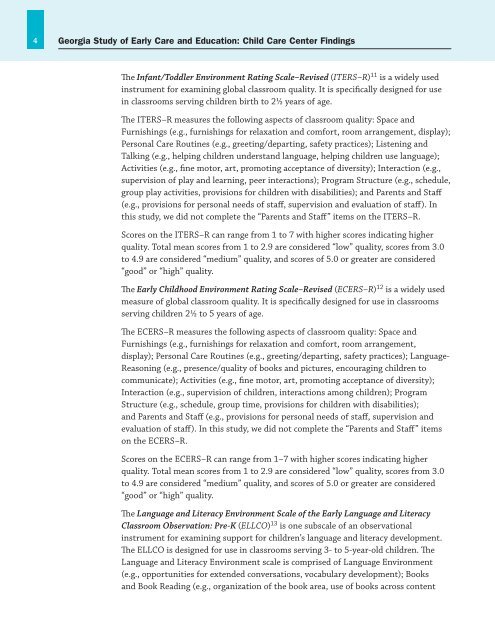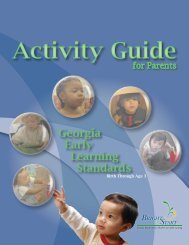Georgia Study of Early Care and Education: Child - Bright from the ...
Georgia Study of Early Care and Education: Child - Bright from the ...
Georgia Study of Early Care and Education: Child - Bright from the ...
Create successful ePaper yourself
Turn your PDF publications into a flip-book with our unique Google optimized e-Paper software.
4 <strong>Georgia</strong> <strong>Study</strong> <strong>of</strong> <strong>Early</strong> <strong>Care</strong> <strong>and</strong> <strong>Education</strong>: <strong>Child</strong> <strong>Care</strong> Center Findings<br />
The Infant/Toddler Environment Rating Scale–Revised (ITERS–R) 11 is a widely used<br />
instrument for examining global classroom quality. It is specifically designed for use<br />
in classrooms serving children birth to 2½ years <strong>of</strong> age.<br />
The ITERS–R measures <strong>the</strong> following aspects <strong>of</strong> classroom quality: Space <strong>and</strong><br />
Furnishings (e.g., furnishings for relaxation <strong>and</strong> comfort, room arrangement, display);<br />
Personal <strong>Care</strong> Routines (e.g., greeting/departing, safety practices); Listening <strong>and</strong><br />
Talking (e.g., helping children underst<strong>and</strong> language, helping children use language);<br />
Activities (e.g., fine motor, art, promoting acceptance <strong>of</strong> diversity); Interaction (e.g.,<br />
supervision <strong>of</strong> play <strong>and</strong> learning, peer interactions); Program Structure (e.g., schedule,<br />
group play activities, provisions for children with disabilities); <strong>and</strong> Parents <strong>and</strong> Staff<br />
(e.g., provisions for personal needs <strong>of</strong> staff, supervision <strong>and</strong> evaluation <strong>of</strong> staff). In<br />
this study, we did not complete <strong>the</strong> “Parents <strong>and</strong> Staff” items on <strong>the</strong> ITERS–R.<br />
Scores on <strong>the</strong> ITERS–R can range <strong>from</strong> 1 to 7 with higher scores indicating higher<br />
quality. Total mean scores <strong>from</strong> 1 to 2.9 are considered “low” quality, scores <strong>from</strong> 3.0<br />
to 4.9 are considered “medium” quality, <strong>and</strong> scores <strong>of</strong> 5.0 or greater are considered<br />
“good” or “high” quality.<br />
The <strong>Early</strong> <strong>Child</strong>hood Environment Rating Scale–Revised (ECERS–R) 12 is a widely used<br />
measure <strong>of</strong> global classroom quality. It is specifically designed for use in classrooms<br />
serving children 2½ to 5 years <strong>of</strong> age.<br />
The ECERS–R measures <strong>the</strong> following aspects <strong>of</strong> classroom quality: Space <strong>and</strong><br />
Furnishings (e.g., furnishings for relaxation <strong>and</strong> comfort, room arrangement,<br />
display); Personal <strong>Care</strong> Routines (e.g., greeting/departing, safety practices); Language-<br />
Reasoning (e.g., presence/quality <strong>of</strong> books <strong>and</strong> pictures, encouraging children to<br />
communicate); Activities (e.g., fine motor, art, promoting acceptance <strong>of</strong> diversity);<br />
Interaction (e.g., supervision <strong>of</strong> children, interactions among children); Program<br />
Structure (e.g., schedule, group time, provisions for children with disabilities);<br />
<strong>and</strong> Parents <strong>and</strong> Staff (e.g., provisions for personal needs <strong>of</strong> staff, supervision <strong>and</strong><br />
evaluation <strong>of</strong> staff). In this study, we did not complete <strong>the</strong> “Parents <strong>and</strong> Staff” items<br />
on <strong>the</strong> ECERS–R.<br />
Scores on <strong>the</strong> ECERS–R can range <strong>from</strong> 1–7 with higher scores indicating higher<br />
quality. Total mean scores <strong>from</strong> 1 to 2.9 are considered “low” quality, scores <strong>from</strong> 3.0<br />
to 4.9 are considered “medium” quality, <strong>and</strong> scores <strong>of</strong> 5.0 or greater are considered<br />
“good” or “high” quality.<br />
The Language <strong>and</strong> Literacy Environment Scale <strong>of</strong> <strong>the</strong> <strong>Early</strong> Language <strong>and</strong> Literacy<br />
Classroom Observation: Pre-K (ELLCO) 13 is one subscale <strong>of</strong> an observational<br />
instrument for examining support for children’s language <strong>and</strong> literacy development.<br />
The ELLCO is designed for use in classrooms serving 3- to 5-year-old children. The<br />
Language <strong>and</strong> Literacy Environment scale is comprised <strong>of</strong> Language Environment<br />
(e.g., opportunities for extended conversations, vocabulary development); Books<br />
<strong>and</strong> Book Reading (e.g., organization <strong>of</strong> <strong>the</strong> book area, use <strong>of</strong> books across content

















